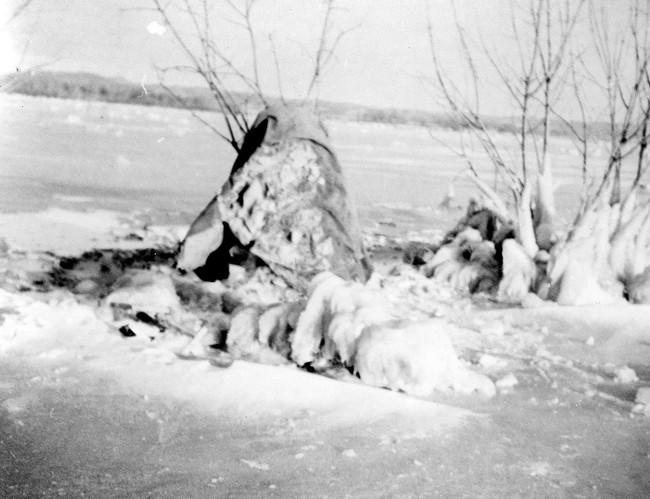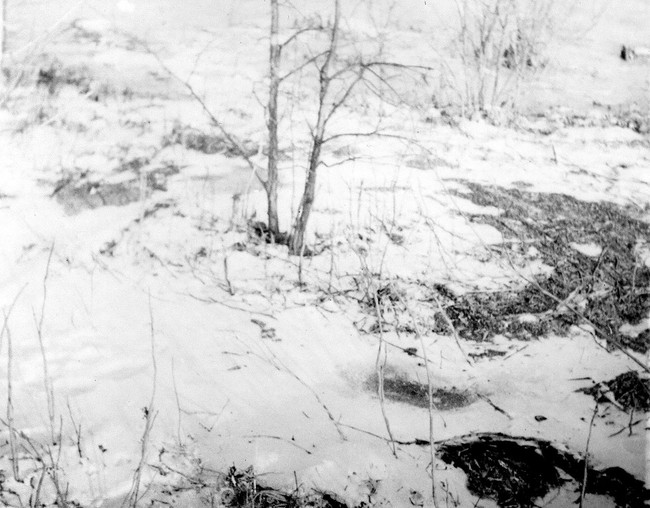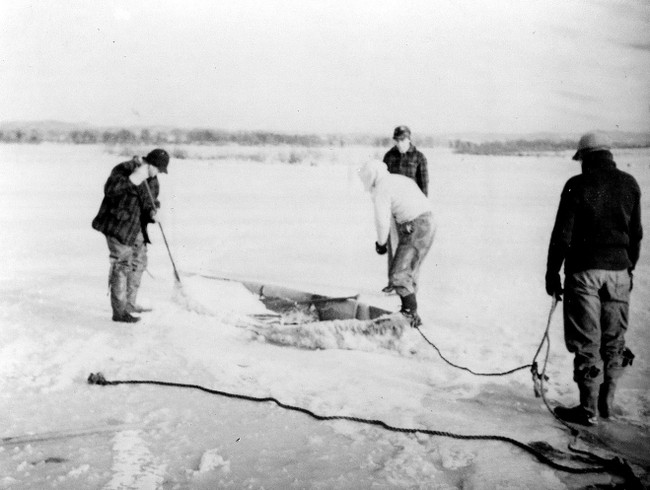Morning: Promise of a Mild Holiday
Monday, November 11, 1940, began as a beautiful, calm day across the Upper Midwest; the air was soft and warm in La Crosse, Wisconsin, where three rivers meet — the Mississippi, Wisconsin, and La Crosse — and all the backwaters shone in sunlight.
Two high school friends, 18-year-old LaVerne “Vern” Rieber and 16-year-old Dick Bice, listened to the morning Armistice Day ceremony, then grabbed their shotguns, duck decoys, Rieber’s dog, and a homemade dugout canoe, and drove to Brice Prairie, a shallow expanse north of town on Lake Onalaska.
The day started well, with the ducks riding the strong southern wind and the decoys floating peacefully. The boys ignored the few light sprinkles on a day that felt more like early-October than mid-November.
Noon: The Barometer Collapses
The storm that would become legend stirred around midday, when the barometer plunged to 28.72 inches Hg in La Crosse — an unheard-of low for November.
Soon, warm, southern air slammed into an Arctic system diving down from Canada, producing a “panhandle-hook” system that swept from Kansas to Michigan.
Around the same time, Vern shot a mallard that dropped into open water. He hopped into his dugout and paddled after it, planning a quick return trip, but the wind had other ideas: it suddenly shifted, roaring out of the northwest.
The air temperature dropped from around 60 degrees to near freezing in less than two hours. Rieber’s homemade dugout and paddle weren’t a match for the gale; he was pushed away from Bice, toward another island, and forced ashore.
Afternoon: Rain to Ice to Snow
Things truly became ugly by early afternoon, when the rain turned to sleet, then to a whiteout snowstorm. The Mississippi backwaters, once calm as glass, became the scene of nature’s fury.
Because the day began so warm, hunters wore lightweight gear — many in waders and canvas jackets — and realized too late that they were in trouble.
Once on shore, Rieber dragged his boat up, turned it over, and crawled underneath with his dog. Fortunately for him, soon after, another hunter who couldn’t reach him threw a tarp, which he wrapped around a tree as temperatures continued to fall.
Vern told me that the tarp saved his life.

Looking at the length of Vern Rieber’s dugout
Bice, without any cover and isolated on the original island, stayed alive by running in circles all night, stamping his feet to keep feeling his legs.
 The area on the island where Vern Rieber spent the night during the storm
The area on the island where Vern Rieber spent the night during the storm
Nightfall: The Long Vigil
Their families panicked back in La Crosse. Rieber’s father, Joe, and Bice’s father, Ray, drove to the landing where they found the boys’ car, but nothing else.

Inches of ice on Vern Rieber’s dugout
They tried launching a wooden boat, but the gale beat them back with towering waves. The only thing they could do was sit in their idling car throughout the night, with the headlights on.
 The canvas that sheltered Vern Rieber
The canvas that sheltered Vern Rieber
Fighting sleep, Vern forced himself to alternate between sitting and standing to stay awake, while the wind screamed through the reeds and snow buried the decoys.
When telling me the story, Vern admitted to a bit of mischief and, with a sly smile, talked about how he broke the boredom.
“The dog and I were walking laps around the tree with the tarp all night. We weren’t far from a lighthouse that kept the area partially lit. Now and then, the rotating light would flash over some flying ducks. Because I had shells and wanted to stay busy, I would take several shots throughout the night. I don’t know if I hit anything, but at least it was something to do.”
A million turkeys across Wisconsin and Minnesota froze to death as temperatures plunged below ten degrees; cattle and orchard trees met the same fate.
Rescue on the Ice
The next morning, Lake Onalaska was covered with a thin sheet of ice. Local outdoorsman Burton Smith managed to slide a boat across the crust and reached Vern first, seeing him pale and trembling but alive.
Around the same time, Ray Bice shot the padlock off a heavier skiff, broke through the ice, and found his son still alive and moving to fight off frostbite.
Both young men were safe by mid-afternoon. They were among the few who survived.
Unfortunately, dozens of hunters along the Mississippi weren’t so lucky.
A Young Bud Grant’s Close Call
Another teenage hunter, farther north in Wisconsin, learned just how quickly the world could turn. Bud Grant, who would one day lead the Minnesota Vikings to four Super Bowls, was hunting on Yellow Lake near Webster.
Grant, along with his friends, was fooled by the early day’s warmth that lured thousands outdoors, leading them to wear short-sleeved shirts.
Their boat nearly capsized when the bow hit the waves, forcing them to abandon it. They then walked along a railroad grade through the blinding snow until they stumbled into a shack, where they waited out the storm for two days.
Afterwards, Grant often recalled learning the existence of the thin line separating preparedness from tragedy, which was the first time he truly understood nature’s power.
The Wider Catastrophe
The Armistice Day Storm killed at least 154 people across the Midwest: 49 in Minnesota, 59 on Lake Michigan, and dozens more in Iowa and Wisconsin.
Twenty-foot drifts of snow, blown from the 26 inches that fell in central Minnesota, stalled trains and snapped power lines. Farmers were found later frozen to death when they got lost between their barns and homes in the whiteout.
Because of the severity of the storm, the U.S. Weather Bureau was reorganized, leading to the creation of regional 24-hour forecasting offices so warnings would never come too late again.
Aftermath: the Men They Became
I believe we all have a handful of people we’ve met in our lives who have greatly influenced us. Vern Rieber, to me, was one of five people whom I looked on as more of a role model than a friend. In his case, however, Vern is my ex-grandfather-in-law. He was a man with an incredibly optimistic disposition, while closely resembling an older Mickey Rooney.
Although he carried that night’s memory for the rest of his life, it wasn’t his only adventure, because a few years later, he found himself fighting in the Philippines during World War II, becoming wounded when a Japanese soldier shot his mortar team with a Type 89 grenade discharger, commonly called the “knee mortar,” hitting the crew, killing two, severely wounding another, and blowing the heel off Vern’s foot.
After coming home from the Pacific, his wife, Jean, developed a debilitating case of rheumatoid arthritis after she gave birth to their youngest daughter, Kathy.
Despite the extreme effect RA had on her hands and body, Jean was among the best artists I’ve ever known.
Within a decade, Vern Rieber had three incredible life experiences that profoundly shaped his character and personality.
Later in life, Dick Bice was an industrial arts teacher. Vern worked as a chief electrician at La Crosse Footwear on Indian Hill in La Crosse, rarely talking about the storm — except, when asked, in measured terms.
Both men lived long lives and never forgot the lesson that a peaceful river could turn into an Arctic trap in a moment.
Their story endures as both a warning and a testament to those who hunt the Mississippi backwaters today, a reminder that even the most seasoned outdoorsman bows before nature’s sudden violence.
Final Thoughts
The Armistice Day Storm was more of a reckoning than a meteorological event, humbling farmers, hunters, and forecasters. For Rieber and Bice, it was the day they transitioned from youth to manhood, separated by a storm, but bound forever by survival.
Their ordeal whispers an unchanging truth to everyone who still spends time along the banks of the Upper Mississippi: there are moments when the sky itself decides who lives and who doesn’t.
 A view of the east bank of Lake Onalaska following the storm
A view of the east bank of Lake Onalaska following the storm
History That Still Breathes
Stories like La Verne Rieber’s — and even young Bud Grant’s brush with death — remind us that the past isn’t a relic; it’s a compass. If you value in-depth, eyewitness-driven storytelling that preserves history’s human edge, join the PJ Media VIP community today. Unlock exclusive analysis, extended features, and my full archive of historical deep dives.








